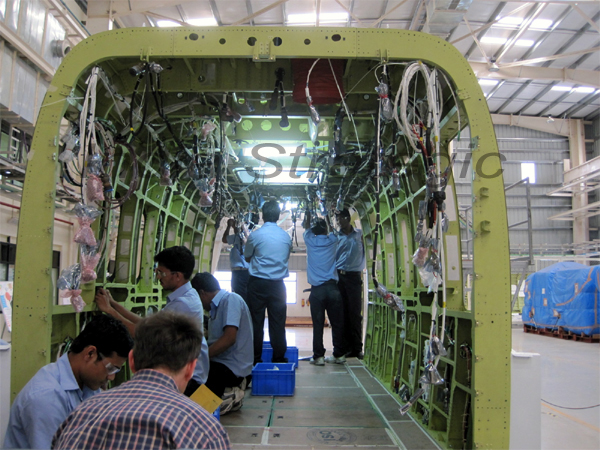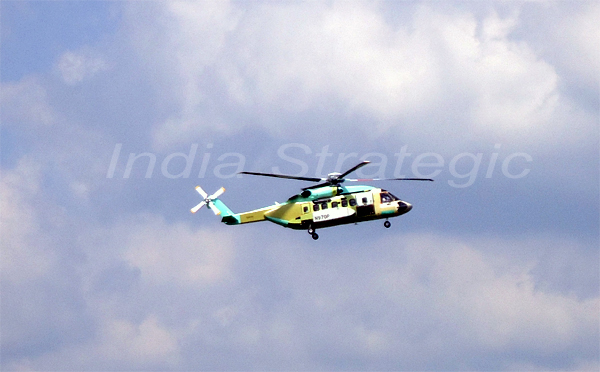|
Air Vice Marshal Arvind Walia (Retd), Sikorsky’s
Regional Executive for India and South Asia, told
India Strategic that the Tatas
had already supplied 15 airframes to the US company,
which is fitting them with Cockpit, engines, systems
and rotors. These completed helicopters are then
ready for supply to global customers.
The flight tests on the first Tata-made S 92
cabin have progressed satisfactorily, and the
helicopter is now being customised for supply
to Lider Aviacao of Brazil. Lider charters both
aircraft and helicopters for multi applications,
including for servicing offshore oil installations.
Sikorsky and Tata groups already have a 26:74
partnership joint venture simply called TARA,
which manufactures and supplies about 4,300 detailed
components to the Tata Advanced Systems Ltd. (TASL)
in Hyderabad. TASL, a Tata company, makes the
cabins, fits them with these components, and then
sends the finished airframes to the Sikorsky facility
at Coatsville in Pennsylvania in the US.
AVM Walia said that so far, 15 airframes had
been supplied by the TASL. At present, the airframes
are being produced at the Low Rate Initial Production
(LRIP) of 2/ month but should be moved to 3/ month
in accordance with the demand by 2013.
The production moves as in a conveyor belt and
the made-in-India airframes (cabins) would operate
anywhere in the world, from wherever the orders
come.
In meetings with this writer in London recently,
two of Sikorsky’s top executives said that
Sikorsky would develop India as a hub for manufacturing
in the coming years, depending though on the Indian
and international requirements.
Steve Estill, Vice President strategic partnerships,
and Bob Kokorda, Vice President worldwide sales
and marketing, said that while the S 92 is primarily
a civilian helicopter, Sikorsky was open to manufacture
military helicopters in India also.
A significant offer by the company, they pointed
out, is to develop high altitude helicopter for
India which could be deployed comfortably in heights
above 20,000 feet for both military and logistic
operations.

India has the toughest battlefield requirements,
like no other in the world, due to the Himalayan
heights, as in Siachen.
Both Mr Kakorda and Mr Estill said that Sikorsky
could do R&D for this exclusive venture either
in collaboration with an Indian entity like HAL,
or by itself, depending upon the mandate given
by the Indian Government. The proposed machine
would involve newer technologies and high use
of advanced composite materials.
AVM Walia said that he had already mentioned
this offer to Indian authorities in discussions.
“The Indian specifications are very difficult
and any solutions would need unique rotor technologies
and advanced performance parameters.”
The idea is to develop a helicopter which can
do reconnaissance and land at Siachen-like heights
with full load of cargo or troops, a capability
which does not exist anywhere in the world yet.
At present, IAF and Indian Army operate HAL
made Cheetal and Dhruv helicopters with partial
load in extreme conditions and with extreme care.
Notably, Sikorsky has already signed an agreement
with the Tatas to produce military helicopters
in India.
AVM Walia pointed out that it took only four
years to produce the airframes after the initial
agreement between the two groups in 2007. The
first airframe, or cabin, was produced in October
2011 and sent to the US for installation of Cockpit,
engines, systems and whatever.
“We mean well and we mean business, on-time
performance and deliveries, precision qualities
and latest technologies,” AVM Walia observed.
Neither of the three Sikorsky officers disclosed
the cost of an airframe but industry sources said
that normally it should be around 15 per cent
of the flying machine, depending upon the systems
and avionics.
The S 92 is a large, twin-engine rotorcraft
with four blades. It can be used both for civil
and military deployment.

|